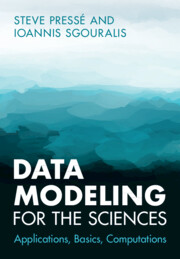Refine search
Actions for selected content:
17 results
Mediators of psychotic-like experiences in community youths after trauma: positive sense of agency and post-traumatic stress symptoms
-
- Journal:
- BJPsych Open / Volume 11 / Issue 6 / November 2025
- Published online by Cambridge University Press:
- 10 November 2025, e274
-
- Article
-
- You have access
- Open access
- HTML
- Export citation
REDUCING TYPE 1 CHILDHOOD DIABETES IN SAUDI ARABIA BY IDENTIFYING AND MODELLING ITS KEY PERFORMANCE INDICATORS
- Part of
-
- Journal:
- Bulletin of the Australian Mathematical Society / Volume 112 / Issue 3 / December 2025
- Published online by Cambridge University Press:
- 09 June 2025, pp. 574-576
- Print publication:
- December 2025
-
- Article
-
- You have access
- HTML
- Export citation
4 - Evaluation of Predictive Models
- from Part I - Framework for Multivariate Biomarker Discovery
-
- Book:
- Multivariate Biomarker Discovery
- Published online:
- 30 May 2024
- Print publication:
- 06 June 2024, pp 44-75
-
- Chapter
- Export citation
Interaction between mental disorders and social disconnectedness on mortality: a population-based cohort study
-
- Journal:
- The British Journal of Psychiatry / Volume 225 / Issue 1 / July 2024
- Published online by Cambridge University Press:
- 06 May 2024, pp. 282-289
- Print publication:
- July 2024
-
- Article
-
- You have access
- Open access
- HTML
- Export citation

Data Modeling for the Sciences
- Applications, Basics, Computations
-
- Published online:
- 17 August 2023
- Print publication:
- 31 August 2023
Growth and yield estimation of banana through mathematical modelling: a systematic review
-
- Journal:
- The Journal of Agricultural Science / Volume 160 / Issue 3-4 / June 2022
- Published online by Cambridge University Press:
- 23 May 2022, pp. 152-167
-
- Article
-
- You have access
- HTML
- Export citation
What is the promise of personalised nutrition?
-
- Journal:
- Journal of Nutritional Science / Volume 10 / 2021
- Published online by Cambridge University Press:
- 06 April 2021, e23
-
- Article
-
- You have access
- Open access
- HTML
- Export citation
7 - Mathematical Expressions for the Species–Area Relationship and the Assumptions behind the Models
- from Part III - Theoretical Advances in Species–Area Relationship Research
-
-
- Book:
- The Species–Area Relationship
- Published online:
- 11 March 2021
- Print publication:
- 18 March 2021, pp 157-184
-
- Chapter
- Export citation

Biostatistics with R
- An Introductory Guide for Field Biologists
-
- Published online:
- 18 September 2020
- Print publication:
- 30 July 2020
-
- Textbook
- Export citation
MODELLING AND MONITORING MATERNAL MORTALITY RATE IN SOUTH SUDAN
- Part of
-
- Journal:
- Bulletin of the Australian Mathematical Society / Volume 103 / Issue 2 / April 2021
- Published online by Cambridge University Press:
- 11 September 2020, pp. 343-345
- Print publication:
- April 2021
-
- Article
-
- You have access
- Export citation
FREQUENTIST INFERENCE IN INSURANCE RATEMAKING MODELS ADJUSTING FOR MISREPRESENTATION
-
- Journal:
- ASTIN Bulletin: The Journal of the IAA / Volume 49 / Issue 1 / January 2019
- Published online by Cambridge University Press:
- 01 March 2019, pp. 117-146
- Print publication:
- January 2019
-
- Article
- Export citation
Predicting Fatigue 12 Months after Child Traumatic Brain Injury: Child Factors and Postinjury Symptoms
-
- Journal:
- Journal of the International Neuropsychological Society / Volume 24 / Issue 3 / March 2018
- Published online by Cambridge University Press:
- 04 October 2017, pp. 224-236
-
- Article
- Export citation
Older Adults’ Online Dating Profiles and Successful Aging
-
- Journal:
- Canadian Journal on Aging / La Revue canadienne du vieillissement / Volume 35 / Issue 4 / December 2016
- Published online by Cambridge University Press:
- 24 October 2016, pp. 479-490
-
- Article
- Export citation
Statistical Analyses of Hellin's Law
-
- Journal:
- Twin Research and Human Genetics / Volume 12 / Issue 2 / 01 April 2009
- Published online by Cambridge University Press:
- 21 February 2012, pp. 191-200
-
- Article
-
- You have access
- Export citation
Maternal Age and Temporal Effects on Stillbirth Rates
-
- Journal:
- Twin Research and Human Genetics / Volume 11 / Issue 5 / 01 October 2008
- Published online by Cambridge University Press:
- 21 February 2012, pp. 558-566
-
- Article
-
- You have access
- Export citation
Evaluation of regression models for above-ground biomass determination in Amazon rainforest
-
- Journal:
- Journal of Tropical Ecology / Volume 10 / Issue 2 / May 1994
- Published online by Cambridge University Press:
- 10 July 2009, pp. 207-218
-
- Article
- Export citation
Body mass index: a measure of fatness or leanness?
-
- Journal:
- British Journal of Nutrition / Volume 73 / Issue 4 / April 1995
- Published online by Cambridge University Press:
- 09 March 2007, pp. 507-516
- Print publication:
- April 1995
-
- Article
-
- You have access
- Export citation
